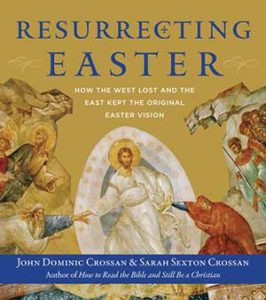Resurrecting Easter: How the West Lost and the East Kept the Original Easter Vision
Reviewed by Ken Jacobsen
September 1, 2019
 By John Dominic Crossan and Sarah Sexton Crossan. HarperOne, 2018. 224 pages. $39.99/hardcover; $19.99/eBook.
By John Dominic Crossan and Sarah Sexton Crossan. HarperOne, 2018. 224 pages. $39.99/hardcover; $19.99/eBook.
John Dominic Crossan, author of numerous thought-provoking books on the historical Jesus and Paul and on the emergent Christian movement, teams here with his wife, Sarah Sexton Crossan, in a new book, Resurrecting Easter. This work is a detailed and finely wrought art-history travelog from their years of West to East travel across the former Christian Roman Empire. It centers around one great insight, which the Crossans have discovered in the differing iconographies: the Western (Roman) Church, especially after the split with the Eastern (Orthodox) Church in 1054 CE, depicts the resurrection largely as the individual resurrection of Jesus, while the Eastern Church depicts it as a universal event in which Jesus, in some way, raises all of us with him, the dead and the living, even the whole creation.
Because the event of Jesus’s resurrection at Easter, his overcoming of death, is not described in the New Testament scriptures, faith communities have been free over the years to imagine it in various ways. The Eastern Church (which eventually spread from Greece and the Middle East into Romania, Georgia, Russia, and the Slavic cultures) often shows Jesus, in its artistic renderings of the resurrection, grasping Adam and Eve (representing all of humanity) by the hand and lifting them out of hell, out of their/our state of suffering, into a new life. Western depictions indicate that Jesus’s resurrection occurs beyond us, out of sight (until some variously envisioned Second Coming).
The Crossans’ central point, in this detailed text illustrated with many paintings, mosaics, and icons, is that the West largely lost this vision of a universal resurrection, while the East has retained it to this day. This difference has great implications for our differing ways of understanding our faith, the role of Jesus, and our part of the Christian story of salvation.
What might universal resurrection mean for those of us who are not as steeped in theology as the Crossans and others of Catholic or Orthodox tradition? Perhaps it means that each of us, in our very humanness, bears evidence of the resurrection in ourselves and in our bodies—an energy set free in the world at Easter; a new energy of hope, love, justice, and peace; an energy so often taught and demonstrated by Jesus and his followers in the gospel stories and the epistles of the Bible.
Early Friends seem to describe a living infusion of resurrection energy like this as inaugurating their movement in seventeenth-century England, as in George Fox’s words: “Christ has come to teach his people himself.” Perhaps we see this energy expressed today among us in the Quaker testimonies of peace, truth, equality, and simplicity.
The images and message of Resurrecting Easter may prompt us to more fully see and nurture this universal healing energy of Easter in our own faith communities and in the wider world.



Comments on Friendsjournal.org may be used in the Forum of the print magazine and may be edited for length and clarity.